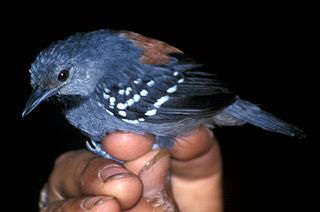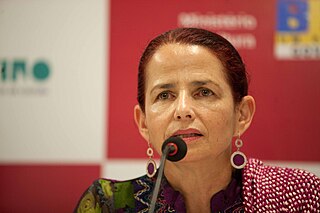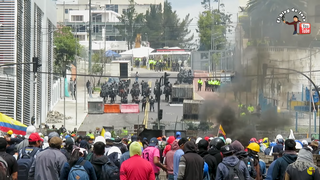The History of Ecuador covers human habitation in the region reaching back 8,000 years

Lucio Edwin Gutiérrez Borbúa served as 43rd President of Ecuador from 15 January 2003 to 20 April 2005. In 2023, he was elected to the National Assembly.

The Confederation of Indigenous Nationalities of Ecuador or, more commonly, CONAIE, is Ecuador's largest indigenous rights organization. The Ecuadorian Indian movement under the leadership of CONAIE is often cited as the best-organized and most influential Indigenous movement in Latin America.

The Pachakutik Plurinational Unity Movement – New Country is a left-wing indigenist party in Ecuador. It was founded primarily as a way to advance the interests of a wide variety of indigenous peoples' organizations throughout Ecuador.

The Cordillera del Cóndor is a mountain range in the eastern Andes that is shared by and part of the international border between Ecuador and Peru.

Rafael Vicente Correa Delgado is an Ecuadorian politician and economist who served as President of Ecuador from 2007 to 2017. The leader of the PAIS Alliance political movement from its foundation until 2017, Correa is a democratic socialist and his administration focused on the implementation of left-wing policies. Internationally, he served as president pro tempore of the UNASUR. Since 2017, he has been living in exile in Belgium.
Mining in Ecuador was slow to develop in comparison to other Latin American countries, in spite of large mineral reserves. As late as 2012, according to the United Nations, Ecuador received less foreign direct investment per person than any other country in Latin America. During the 1980s, mining contributed only 0.7 percent to the Ecuadorian economy and employed around 7,000 people. Minerals were located in regions with little to no access, hindering exploration. Ecuador has reserves of gold, silver, copper, zinc, uranium, lead, sulfur, kaolin and limestone. The latter practically dominated the early industry as it was used in local cement plants.

Corriente Resources was a multinational corporation based in Canada that completed feasibility studies and environmental impact assessments (EIA) for open-pit copper mines in the Ecuadorian rainforest, including the Mirador mine. The Mirador mine is the first industrial scale copper mine to be developed in Ecuador. Corriente Resources also completed explorations of the San Carlos Panantza mine, although development of that project was halted in 2020 by Indigenous opposition.
Ecuador is a country in South America.

The 2010 Ecuadorian crisis took place on 30 September 2010, when National Police operatives blockaded highways, occupied the National Assembly, blocked Mariscal Sucre International Airport in Quito and José Joaquín de Olmedo International Airport in Guayaquil, and took control of the premises of Ecuador TV, in what they claimed was a strike to oppose a government-sponsored law that supposedly reduced their benefits. Unrest and looting were reported in seven provinces of the country because of the lack of law enforcement.
The 2000 Ecuadorian coup d'état took place on 21 January 2000 and resulted in President Jamil Mahuad being deposed, and replaced by Vice President Gustavo Noboa. The coup coalition brought together a short-lived junta composed by the country's most powerful indigenous group, Confederation of Indigenous Nationalities of Ecuador (CONAIE), and a group of junior military officers led by Lieutenant Colonel Lucio Gutiérrez.

The 2011 Bolivian protests were a series of demonstrations by indigenous peoples who opposed the construction of the Villa Tunari – San Ignacio de Moxos Highway through the Isiboro Sécure National Park and Indigenous Territory, the ancestral lands of over 12,000 indigenous residents, from the Chimane, Yuracaré, and Mojeño-Trinitario peoples. The subcentral TIPNIS, the Confederation of Indigenous Peoples of Bolivia (CIDOB), and the highland indigenous confederation CONAMAQ—supported by other indigenous and environmental groups—organised a march from Trinidad, Beni to the national capital La Paz in opposition to the project, beginning on 15 August 2011.

Guillermo Alberto Santiago Lasso Mendoza is an Ecuadorian businessman, banker and politician who served as the 47th president of Ecuador from 2021 to 2023. He was the country's first conservative president in nearly two decades, marking a shift in the country's electorate.

Erika Sylva Charvet is an Ecuadorian politician who was Minister of Culture from 21 April 2010 until 9 May 2013.
The Mirador mine is a large copper mine located in the Amazonian province of Zamora-Chinchipe in southern Ecuador. It is one of the largest copper reserves in Ecuador, and the first industrial-scale copper project to be developed in the country. The project has generated an environmental conflict that is emblematic in the national political debate on mining.
The San Carlos Panantza mine is a large copper mine located in the south of Ecuador in Zamora-Chinchipe Province. San Carlos-Panantza is one of the largest copper reserves in Ecuador and in the world having estimated reserves of 600 million tonnes of ore grading 0.59% copper. The mine is in the Corriente copper belt along with the Mirador mine. It is being developed by ExplorCobres S.A., a subsidiary of the state-owned Chinese company CRCC-Tongguan Investment Co. Ltd that is also developing Mirador.

The 2015 Ecuadorian protests were a series of protests against the government of President Rafael Correa. Protests began in the first week of June, triggered by legislation increasing inheritance and capital gains taxes. By August, an alliance of rural farmworkers, Indigenous federations such as CONAIE, student groups, and labor unions had organised protests involving hundreds of thousands of people with a wide range of grievances, including the controversial tax laws; constitutional amendments removing presidential term limits; expanding oil and mining projects; water, education, and labour policies; a proposed free trade agreement with the European Union; and increasing repression of freedom of speech. On August 15, the government declared a state of exception that allowed the military to crackdown on protests.

The Saraguro is a people of the Kichwa nation most of whom live in Saraguro Canton in the Loja Province of Ecuador. Although most now speak Spanish, Runashimi or Kichwa, a Quechua dialect, is also spoken and language revitalization efforts are being implemented. Likewise, the Saraguro have retained much of their land, customs and traditional dress. According to the INEC's 2010 population census, the total population of Saraguro canton is 30,183, but that total includes both the Indigenous and non-Indigenous people living in Saraguro.

The 2019 Ecuadorian protests were a series of protests and riots against austerity measures including the cancellation of fuel subsidies, adopted by President of Ecuador Lenín Moreno and his administration. Organized protests ceased after indigenous groups and the Ecuadorian government reached a deal to reverse the austerity measures, beginning a collaboration on how to combat overspending and public debt.

A series of protests against the economic policies of Ecuadorian president Guillermo Lasso, triggered by increasing fuel and food prices, began on 13 June 2022. Initiated by and primarily attended by Indigenous activists, in particular the Confederation of Indigenous Nationalities of Ecuador (CONAIE), the protests have since been joined by students and workers who have also been affected by the price increases. Lasso condemned the protests and labelled them as an attempted "coup d'état" against his government.













